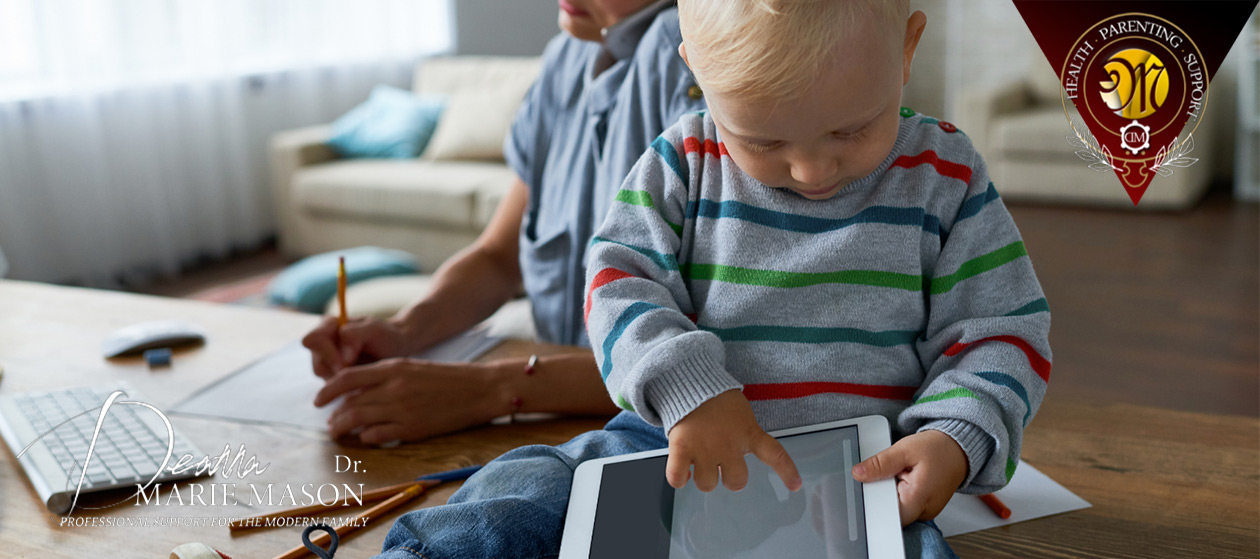Jennifer and Ryan had a beautiful baby boy, Charlie, who was 18 months old. Charlie was 80th percentile for his weight and height. He was walking and meeting most of his developmental milestones on time – except for talking. Charlie did not speak yet. He was unable to tell his parents what he wanted. Instead, he pointed or acted out until they could guess what he needed. Jennifer and Ryan were puzzled why their son was progressing in every area except for speech. Little did they know that handing Charlie their telephone to keep him busy was a big reason that he wasn’t speaking.
The research has been clear for decades that increased television viewing is associated with language delays in early childhood because watching screens reduces parent-child interaction and play. Early language development is critically tied to babies and small children hearing parents speak, looking at faces, and interacting with adults. Having the television on, even if not directly watching it, for children aged 2 to 48 months has been linked to fewer words and less conversation.
Today, screen time is not just limited to televisions but also tablets and smartphones. Studies show that most children under the age of 2 have used mobile devices and other studies reveal that some babies and small children are using mobile devices daily. Parents use these devices with their children to keep them entertained, soothe them, or distract them. Other parents believe that their child will be missing out on educational opportunities if not introduced to technology early.
Since mobile screens are interactive, the use of these devices has a different effect on receptive (listening and understanding) and expressive (speaking) communication than traditional televisions that do not respond to touch. Small children enjoy the interactive nature of the touch screen because there is big change (transformation of color, sound, visual program, volume, etc.) with a small amount of effort (a light touch). This is engaging and stimulating to babies and small children. The continuous nature of the pattern, touch = change, can keep little ones engaged for extended periods of time.
This contrasts with the slow, deliberate and error-filled process of learning to communicate. To learn to speak, babies must start by understanding that sounds form words to represent an object. There is tremendous effort needed for a child to visually take in an object, such as a cup, identify that it has a name, learn the sounds to say that name, and make their mouth and tongue move to create those sounds in such a way that another person can understand. This process is time-intensive and needs lots of practice before success is attained.
While parents may believe that having their babies watch educational programming on tablets or smartphones will improve their child’s learning, the research is clear that babies and small children have difficulty transferring learning across different contexts. Little ones do not learn from watching media, but they do from face-to-face interactions. Babies engage with screens for extended periods of time because they are hyper-stimulated by the visuals, sounds, and the dynamic nature of screen. However, they are not learning.
Little ones learn language and communication by engaging with parents, adults, and older siblings in real-time, face-to-face interactions. The embodied experience of seeing expression, gestures, and the interactions between individuals along with hearing the words, phrasing, tone, and interplay between people is what creates deep and lasting meaning in a baby’s brain to begin to understand the basics of communication. By seeing these interactions over and over on a consistent basis many times a day, our kiddos begin to gain confidence to throw themselves into the interactions first with facial expressions and gestures and, later, sounds and words. Over time, this process evolves into expressive communication in which small children can communicate successfully with those around them.
The impact of mobile media use on our little one’s language development is potentially very harmful. Just increasing our baby’s time watching tablets or smartphones by 30 minutes per day will more than double their risk of having expressive speech delays. And being exposed to more and more audible mobile media device content consistently reduces vocalizations (making sounds), conversational turns (answering parents with a sound response) and word count (number of words said).
Children learn to speak and communicate through direct interaction with those around them. Technology has not yet bridged the multifaceted interaction between humans as they convey ideas, emotions, and needs. Little ones can only learn new words and how to say them if they get a chance to practice. Keeping screen use to a minimum and focusing on interactions between parent and child will help support the development of a good vocabulary and fluidity in using spoken language.
About the instructor
Proactive Parenting
Deanna Marie Mason PhD
More than 20 years of clinical experience helping families:
Bachelor's Degree in Registered Nursing, Master’s Degree in Pediatric Nurse Practitioner and PhD in Nursing. University professor, patient education specialist, pediatric researcher, published author and reviewer to first-line international scientific journals, continuous philanthropic activity related to health promotion and education, wife and mother of two children.







There is evidently a lot to realize about this. I consider you made certain nice points in features also. Ana Engelbert Tirrell
There is noticeably a bundle to know about this. I assume you made certain nice points in options also. Idette Scottie Sokil
I really like your writing style, superb info , thanks for putting up : D. Anna-Diane Hillyer Georgia